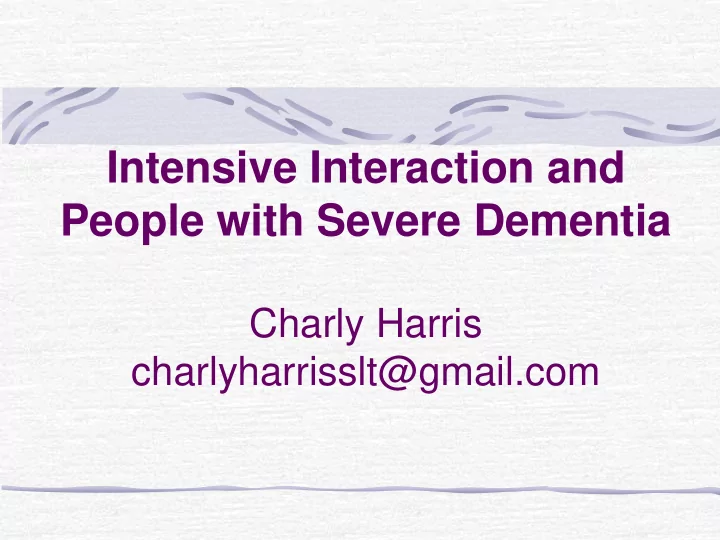

Intensive Interaction and People with Severe Dementia Charly Harris charlyharrisslt@gmail.com
Background Developed in 1994 by Dave Hewett and Melanie Nind. Client-led ‘Entering their world’ Process-focused not task-focused Assumes communicative intent Primarily uses NVC to establish contact
Aims (Firth & Barber, 2011) Genuine and participatory social inclusion Communicative skills acquisition or development Therapeutic support “ A way of finding a connection with someone who is difficult to reach, then building a more equitable and inclusive relationship with them ”
Intensive Interaction in Dementia (Ellis & Astell, 2008) Single Case Study – termed ‘Adaptive Interaction’ Observation – explore current communication context, identify key features. Standard Interaction (baseline) – 10 minutes, closed questions followed by 20 sec. pause. I.I. – 10 minutes, attended to and responded to verbal and non-verbal behaviours, either direct reflection, or reproducing rhythm in some way.
My Study 3 Participants Information gathering – life history, baseline observation, rating of communication skills 4 sessions over the course of a week 5 minutes Standard Interaction followed by 10 minutes Intensive Interaction 2 sessions were ‘Augmented’ with biographically relevant joint-focus items.
Data Collection Holden Communication Scale D = 46/48, F = 26/48, K = 43/48 Positive Response Schedule (Perrin, 1997) Passive Observer recording events and thoughts Reflective Diary after each session
Holden Communication Scale Response Interest in past events Pleasure Humour Names General Orientation General Knowledge Ability to join in games etc Speech Attempts at communication Interest and response to objects Success in communication
Positive Response Schedule Deliberate Body Movement Deliberate Head Movement Vocalisation Looks at Environment Looks at Carer Initiates Interaction Engagement Happy Sad Fear
Results – D
Results – D
Results - F
Results - F
Results - K
Results - K
Reflections & Conclusions Increasing rapport over time, but not strong enough effect to show in quantitative results Physically and emotionally demanding Differences between conditions are enhanced when social interaction items are extracted.
Reflections & Conclusions Joint-focus items work for some people – 1-2 items per session? Best for those scoring over about 38/48 on HCS Post-study – further developments for D & K Some issues with staff understanding Reflexivity and peer support is vital
What Next? Further investigation of benefits over time – longitudinal study Determine appropriate cut-off point on HCS (or similar) Encouraging all staff to engage
References Caldwell, P. (2007) From isolation to intimacy: Making friends without words. London: Jessica Kingsley Publishers. Caldwell, P. (2006) Speaking the other’s language: Imitation as a gateway to relationship. Infant and Child Development, 15, pp. 25-282. Ellis, M.P. and Astell, A.J. (2008) A new approach to communicating with people with advanced dementia: A case study of adaptive interaction (Chapter 8). In Zeedyk, M.S (Ed.), Promoting social interaction for individuals with communicative impairments: Making contact. London: Jessica Kingsley Publishers. Ellis, M. and Astell, A. (2010) Communication and personhood in advanced dementia. Healthcare Counselling and Psychotherapy Journal, 10 (3), pp. 32-35. Firth, G. (2008) A dual aspect process model of Intensive Interaction. British Journal of Learning Disability, 37, pp. 43-49. Firth, G. and Barber, M. (2011) Using Intensive Interaction with a person with a social or communicative impairment. London: Jessica Kingsley Publishers. Nind and Hewett (1994) Access to Communication: Developing the Basics of Communication with People with Severe Learning Difficulties Through Intensive Interaction (1 st edition). London: David Fulton. Perrin, T., May, H. and Anderson, E. (2008) Wellbeing in dementia: An occupational approach for therapists and carers (2 nd edition). London: Churchill Livingstone. Perrin, T. (1997) The Positive Response Schedule for Severe Dementia. Aging and Mental Health, 1(2), 184-191.
Recommend
More recommend